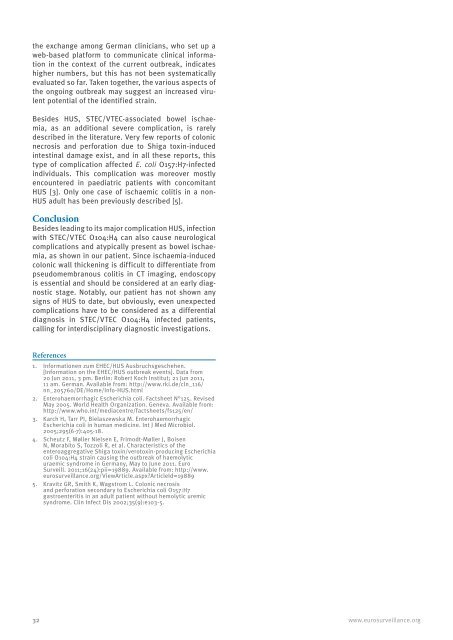Escherichia coli - Eurosurveillance
Escherichia coli - Eurosurveillance
Escherichia coli - Eurosurveillance
You also want an ePaper? Increase the reach of your titles
YUMPU automatically turns print PDFs into web optimized ePapers that Google loves.
the exchange among German clinicians, who set up a<br />
web-based platform to communicate clinical information<br />
in the context of the current outbreak, indicates<br />
higher numbers, but this has not been systematically<br />
evaluated so far. Taken together, the various aspects of<br />
the ongoing outbreak may suggest an increased virulent<br />
potential of the identified strain.<br />
Besides HUS, STEC/VTEC-associated bowel ischaemia,<br />
as an additional severe complication, is rarely<br />
described in the literature. Very few reports of colonic<br />
necrosis and perforation due to Shiga toxin-induced<br />
intestinal damage exist, and in all these reports, this<br />
type of complication affected E. <strong>coli</strong> O157:H7-infected<br />
individuals. This complication was moreover mostly<br />
encountered in paediatric patients with concomitant<br />
HUS [3]. Only one case of ischaemic <strong>coli</strong>tis in a non-<br />
HUS adult has been previously described [5].<br />
Conclusion<br />
Besides leading to its major complication HUS, infection<br />
with STEC/VTEC O104:H4 can also cause neurological<br />
complications and atypically present as bowel ischaemia,<br />
as shown in our patient. Since ischaemia-induced<br />
colonic wall thickening is difficult to differentiate from<br />
pseudomembranous <strong>coli</strong>tis in CT imaging, endoscopy<br />
is essential and should be considered at an early diagnostic<br />
stage. Notably, our patient has not shown any<br />
signs of HUS to date, but obviously, even unexpected<br />
complications have to be considered as a differential<br />
diagnosis in STEC/VTEC O104:H4 infected patients,<br />
calling for interdisciplinary diagnostic investigations.<br />
References<br />
1. Informationen zum EHEC/HUS Ausbruchsgeschehen.<br />
[Information on the EHEC/HUS outbreak events]. Data from<br />
20 Jun 2011, 3 pm. Berlin: Robert Koch Institut; 21 Jun 2011,<br />
11 am. German. Available from: http://www.rki.de/cln_116/<br />
nn_205760/DE/Home/Info-HUS.html<br />
2. Enterohaemorrhagic <strong>Escherichia</strong> <strong>coli</strong>. Factsheet N°125. Revised<br />
May 2005. World Health Organization. Geneva. Available from:<br />
http://www.who.int/mediacentre/factsheets/fs125/en/<br />
3. Karch H, Tarr PI, Bielaszewska M. Enterohaemorrhagic<br />
<strong>Escherichia</strong> <strong>coli</strong> in human medicine. Int J Med Microbiol.<br />
2005;295(6-7):405-18.<br />
4. Scheutz F, Møller Nielsen E, Frimodt-Møller J, Boisen<br />
N, Morabito S, Tozzoli R, et al. Characteristics of the<br />
enteroaggregative Shiga toxin/verotoxin-producing <strong>Escherichia</strong><br />
<strong>coli</strong> O104:H4 strain causing the outbreak of haemolytic<br />
uraemic syndrome in Germany, May to June 2011. Euro<br />
Surveill. 2011;16(24):pii=19889. Available from: http://www.<br />
eurosurveillance.org/ViewArticle.aspx?ArticleId=19889<br />
5. Kravitz GR, Smith K, Wagstrom L. Colonic necrosis<br />
and perforation secondary to <strong>Escherichia</strong> <strong>coli</strong> O157:H7<br />
gastroenteritis in an adult patient without hemolytic uremic<br />
syndrome. Clin Infect Dis 2002;35(9):e103-5.<br />
32 www.eurosurveillance.org

















